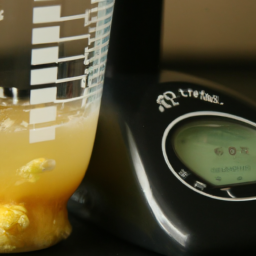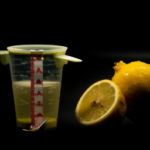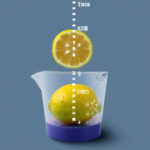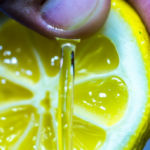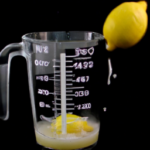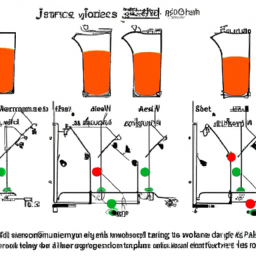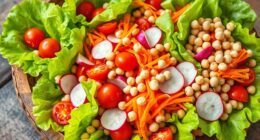Did you know that an average lemon weighs between 3 to 4 ounces and can yield anywhere from 1 to 3 tablespoons of juice?
As someone who enjoys cooking and baking, I’ve often found myself wondering how much lemon juice I can expect to get from half a lemon. The answer, as it turns out, depends on a variety of factors, from the ripeness of the fruit to the tools and techniques used for juicing.
In this article, I’ll explore the different factors that can affect lemon juice yield, including the anatomy of a lemon and the tools and techniques used for juicing.
I’ll also provide tips for maximizing lemon juice yield and offer some guidance on how much juice you can expect to get from half a lemon. Whether you’re a seasoned cook or just getting started in the kitchen, understanding how much juice comes from half a lemon can be a helpful tool in your culinary arsenal.
Key Takeaways
- The amount of juice that comes from half a lemon can be affected by factors such as ripeness, temperature, and juicing technique.
- Lemon anatomy includes pulp, seeds, membranes, and zest, all of which can affect the juice yield.
- There are various tools and techniques for extracting lemon juice, including lemon squeezers, forks, tongs, and hand-squeezing.
- To maximize juice yield, it’s helpful to roll the lemon on a hard surface, warm it in the microwave, use room temperature lemons, and strain the juice. Additionally, lemon juice can be stored in an airtight container in the refrigerator with a pinch of salt or sugar to preserve flavor.
Factors that Affect Lemon Juice Yield
You’ll be surprised at how much juice you can get from a lemon half, but it all depends on factors affecting citrus fruit yield.
The ripeness of the fruit is one of the most important factors to consider. A ripe lemon is softer and juicier than an unripe one, so it will yield more juice.
The temperature of the lemon can also affect juice yield. A lemon at room temperature will yield more juice than a cold lemon because the heat loosens the juice cells in the fruit.
Lastly, the way you squeeze the lemon can make a difference. Pressing the lemon down and twisting it back and forth will yield more juice than just squeezing it.
It is important to note that lemon juicing techniques can also affect the amount of juice you get from half a lemon. Some people prefer to cut the lemon in half and then squeeze it with their hands. Others use a citrus squeezer or a reamer to extract the juice.
Regardless of the method, understanding lemon anatomy is key to getting the most juice out of the fruit. With that in mind, let’s take a closer look at the structure of a lemon.
Understanding Lemon Anatomy
The anatomy of a lemon can be quite complex, with its outer layer of zest protecting the juicy pulp inside. Understanding the different parts of a lemon can help in maximizing its juice yield. Here are the key components of a lemon’s anatomy:
-
Pulp: The fleshy interior of a lemon, where the juice is stored. Lemons can have varying levels of pulp, depending on the variety.
-
Seeds: Small, oval-shaped structures found within the pulp. They can be removed to avoid bitterness in the juice.
-
Membranes: Thin, translucent layers that separate the pulp and seeds. They can be easily removed by cutting the lemon into wedges.
-
Zest: The yellow outer layer of a lemon that contains the essential oils. It can be used to add flavor to dishes and drinks.
Different varieties of lemons can also have varying juice yields due to differences in their anatomy. For example, Meyer lemons have thinner membranes and more pulp, making them ideal for juicing. Knowing the anatomy of lemons can help in selecting the right variety and maximizing the juice yield.
Understanding the anatomy of a lemon is just the first step in getting the most juice out of it. In the next section, we’ll explore the tools and techniques for juicing lemons.
Tools for Juicing Lemons
To get the most out of your lemons, it’s essential to have the right tools for juicing, and luckily, there are a few simple items you probably already have in your kitchen.
Lemon squeezers are an excellent tool to extract juice from lemons, but if you don’t have one, you can use alternatives like a fork, a pair of tongs, or your hands. Simply cut the lemon in half, hold it over a bowl, and squeeze it with the tool of your choice.
Keep in mind that using your hands can be messy and may not be the most efficient method, but it works in a pinch. Another lemon juicing hack is to warm the lemon in the microwave or roll it on a flat surface before juicing. This softens the fruit and makes it easier to extract the juice.
You can also use a citrus reamer or a wooden spoon to get the most juice out of your lemons. Once you have extracted the juice, be sure to strain it to remove any pulp or seeds that may have fallen in.
With these simple tools and techniques, you can easily extract the maximum amount of juice from your lemons. Now that you know about the different tools and hacks for juicing lemons, let’s move on to techniques for juicing them.
Techniques for Juicing Lemons
When it comes to juicing lemons, there are several techniques that I find most effective. The first is hand-squeezing, which involves using my hands to press and twist the lemon halves until all the juice is extracted.
Another technique is using a fork to pierce the lemon flesh and then twist it to release the juice.
Finally, I sometimes use a spoon to scoop out the flesh and then squeeze it over a bowl to collect the juice.
Each of these techniques can be useful depending on the amount of juice you need and the tools you have available.
Hand-Squeezing
Ready to get your hands messy? Squeezing half a lemon by hand can yield about 1-2 tablespoons of juice depending on its size and ripeness.
While it may seem like a simple and straightforward task, there are actually some benefits to hand squeezing that you may not have considered. For one, hand squeezing allows you to control the amount of pressure you apply, which can help you extract more juice without also getting too much of the bitter oils from the lemon peel. Additionally, it’s a great way to get a little bit of exercise and build some hand strength!
Of course, there are also alternative hand squeezing techniques you can try if you want to get the most out of your lemons. For example, you can roll the lemon on a hard surface before cutting it in half to help release more juice. Or, you can try using a citrus reamer, which is a tool designed specifically for juicing lemons (and other citrus fruits).
Regardless of which method you choose, hand squeezing is a quick and easy way to get some fresh lemon juice for your recipes. Now, let’s move on to another technique: using a fork to extract even more juice from your lemons!
Using a Fork
Now, you can easily extract every last drop of lemon juice by using a fork to press and twist the flesh of the lemon. This method is perfect for those who don’t have a citrus juicer or a handheld squeezer.
Simply cut the lemon in half, hold one half with the cut side up, and insert the fork into the center. Press and twist the fork back and forth, applying gentle pressure to the lemon flesh. You’ll see the juice start to flow out, and you can continue to press and twist until you’ve extracted as much juice as possible.
If you don’t have a fork on hand, there are a few alternatives you can try. One method is to roll the lemon back and forth on a hard surface, like a cutting board, before cutting it in half. This will help to loosen up the juice inside.
Another option is to use your hands to squeeze the lemon, but this may not be as effective as using a tool.
In the next section, we’ll explore another tool-free method for extracting lemon juice: using a spoon.
Using a Spoon
Earlier, we talked about using a fork to extract juice from half a lemon, but if the lemon is too soft, using a fork may not be the best option. In such cases, using a spoon may be a better alternative.
To use a spoon, simply cut the lemon in half and hold one half in your hand. Then, use the spoon to scoop out the flesh and squeeze it gently to release the juice. You can also use a straw to pierce the flesh and extract the juice, but be careful not to push too hard and break the straw.
Alternative methods for extracting lemon juice include using a citrus juicer, a hand-held juicer, or simply squeezing the lemon by hand. Each of these methods has its own advantages and disadvantages, so it’s important to choose the method that works best for you.
When it comes to maximizing lemon juice yield, there are a few tips you can follow. One of the most important is to roll the lemon on a hard surface before cutting it. This helps to break down the membranes inside the lemon and makes it easier to extract the juice. Another tip is to microwave the lemon for a few seconds before cutting it, which can help to soften the fruit and make it easier to juice.
Tips for Maximizing Lemon Juice Yield
To maximize the juice yield from lemons, I’ve found that rolling the lemon on a hard surface before juicing helps to break down the fruit’s fibers and release more juice.
Another technique that works well is microwaving the lemon for a few seconds to soften the fruit and make it easier to extract the juice.
Finally, using room temperature lemons rather than cold ones can also lead to more juice output.
Roll the Lemon
Simply squeeze and swirl the lemon to extract the succulent juice. But if you want to maximize the amount of juice you get from the fruit, rolling the lemon beforehand can help. Rolling the lemon helps to break down the membranes inside the fruit, releasing the juice more easily.
Here are three benefits of rolling citrus fruits:
-
Even distribution: Rolling the lemon ensures that the juice is evenly distributed throughout the fruit, making it easier to extract.
-
Increased yield: By breaking down the membranes, rolling the lemon can increase the amount of juice you get from the fruit.
-
Faster extraction: Rolling the lemon beforehand can make it easier to extract the juice more quickly, which can be helpful if you’re in a hurry.
Now that you’ve rolled your lemon, it’s time to move on to the next step: microwaving the lemon.
Microwave the Lemon
After trying the rolling technique, it’s time to explore other ways to extract juice from a lemon. Alternative methods, such as microwaving the lemon, can be a game-changer for those who want to save time and effort. However, it’s essential to take safety precautions to avoid any accidents in the kitchen.
To microwave a lemon, cut it in half and place it in a microwave-safe dish with a tablespoon of water. Cover the dish with a microwave-safe lid or plastic wrap, leaving a small vent to release steam. Microwave the dish for 10 to 20 seconds, or until the lemon is warm to the touch. This method softens the lemon and makes it easier to extract juice, resulting in more juice than just squeezing a cold lemon.
When using this method, it’s important to be careful when handling the hot lemon and dish. Use oven mitts or a towel to carefully remove the dish from the microwave. Also, be mindful of the steam that may escape when removing the lid or plastic wrap. By taking these precautions, you can safely and easily extract more juice from a lemon.
Using alternative methods to extract juice from a lemon can be a great way to get the most out of your fruits. However, it’s important to remember that the temperature of the lemon can affect how much juice you get. This is why it’s recommended to use room temperature lemons. Let’s explore more about the benefits of using room temperature lemons in the next section.
Use Room Temperature Lemons
Did you know that using room temperature lemons can bring out more flavor and acidity in your recipes? When lemons are stored in cold temperatures, their natural oils and juices can become dormant, resulting in a less juicy and flavorful lemon.
By allowing your lemons to come to room temperature before juicing them, you can ensure that you are getting the most out of your citrus. To store your lemons at room temperature, simply place them in a bowl or basket on your kitchen counter away from direct sunlight. Avoid storing your lemons near any heat sources, as this can cause them to dry out and lose their juice.
By keeping your lemons at room temperature, you can have them ready to use whenever you need a burst of citrus in your recipes. Now that you know how to properly store your lemons, let’s move on to the next step: how much juice to expect from half a lemon.
How Much Juice to Expect from Half a Lemon
You’ll be surprised at how much juice you can get from just half a lemon! There are several ways to extract lemon juice, but one of the most common and effective methods is to roll the lemon on a hard surface before cutting it in half. This helps to break down the membranes inside the lemon and release the juice.
Using fresh lemon juice in your cooking and drinks has many benefits. Not only does it add a bright, tangy flavor, but it also provides a good source of vitamin C and other antioxidants.
If you’re planning to use half a lemon in a recipe, you can expect to get around 1-2 tablespoons of juice, depending on the size and ripeness of the lemon. With this knowledge, you can confidently measure out the right amount of juice for your dish or drink.
Speaking of which, let’s explore some delicious recipes that call for half a lemon!
Recipes that Call for Half a Lemon
When using half a lemon in your cooking, try incorporating it in dishes like grilled chicken, roasted vegetables, or a refreshing summer salad for a burst of citrus flavor and added health benefits. Lemon juice not only adds a tangy taste to your dishes, but it also contains vitamin C and antioxidants that are beneficial for your health. Here are some recipes that call for half a lemon:
| Recipe | Ingredients |
|---|---|
| Grilled Chicken | 1/2 lemon, chicken breasts, olive oil, garlic, salt, pepper |
| Roasted Vegetables | 1/2 lemon, mixed vegetables (carrots, zucchini, bell peppers, etc.), olive oil, salt, pepper |
| Summer Salad | 1/2 lemon, mixed greens, cherry tomatoes, cucumber, feta cheese, olive oil, salt, pepper |
Incorporating half a lemon in these recipes can add a bright and refreshing taste to your dishes. Additionally, the health benefits of lemon juice can boost your immune system, aid in digestion, and improve your skin health.
Moving on to the next section, if you don’t have any lemons on hand, there are other substitutes for lemon juice that you can use in your cooking.
Substitutes for Lemon Juice
I just finished discussing recipes that call for half a lemon, but what if you don’t have any lemons on hand? Don’t worry, there are plenty of lemon juice alternatives that you can use in your cooking and baking.
While nothing quite matches the unique flavor of lemon juice, there are several ingredients that can add a similar tanginess to your dishes. Plus, some of these alternatives offer additional health benefits that you won’t find in lemon juice.
Here are some lemon juice alternatives to consider:
- Lime juice: This citrus fruit has a similar flavor to lemon and is a great substitute in recipes that call for lemon juice.
- Vinegar: Both white vinegar and apple cider vinegar can add a tangy flavor to your dishes. Just be sure to use them in moderation as they can be quite strong.
- Yogurt: If you’re looking for a creamy alternative to lemon juice, try using plain yogurt instead. It adds a tangy flavor and can help thicken sauces and dressings.
In addition to providing substitutes for lemon juice, it’s also worth noting the health benefits of lemon juice. Lemon juice is high in vitamin C, which can help boost your immune system and protect against illness. It’s also a good source of antioxidants and can aid digestion. So, while you may need to use a substitute in a pinch, it’s always a good idea to keep some fresh lemons on hand for their health benefits.
When it comes to storing lemon juice, there are a few steps you can take to ensure it stays fresh and flavorful.
Storing Lemon Juice
To keep your lemon juice fresh and flavorful, it’s important to store it in an airtight container in the refrigerator. This is because lemon juice is highly susceptible to oxidation, which can cause it to lose its tangy taste and nutritional value. Moreover, storing lemon juice at room temperature can speed up spoilage and bacterial growth, which can lead to foodborne illnesses.
When storing lemon juice, it’s best to use a glass or plastic container with a tight-fitting lid. Make sure to fill the container to the top to minimize the amount of air inside, which can cause the juice to oxidize faster. You can also add a pinch of salt or sugar to the juice to help preserve its flavor and prevent bacterial growth.
Remember to label the container with the date when you made the juice, so you can keep track of its freshness. With these simple tips, you can enjoy fresh and tangy lemon juice for up to a week or longer.
Frequently Asked Questions
Can you use bottled lemon juice instead of fresh lemon juice in recipes that call for half a lemon?
I highly recommend using fresh lemon juice instead of bottled for the best taste in recipes. Bottled juice lacks the bright, tangy flavor of fresh lemons. The benefits of using fresh juice are undeniable and worth the extra effort.
Is it necessary to remove the seeds from the lemon before juicing it?
Removing lemon seeds when juicing is unnecessary, as they can be strained out later. However, using fresh lemon juice is recommended for optimal flavor, as bottled juice may contain additives and lack the same level of acidity.
How long can you store fresh lemon juice in the refrigerator?
When it comes to storing fresh lemon juice, the best method is to keep it in an airtight container in the refrigerator. Freezing can prolong shelf life, but may affect taste. As for how long it lasts, it’s best to use within a week. "When life gives you lemons, make lemonade"- but remember to store it properly.
Can you juice a lemon without a juicer or any special tools?
Yes, I can juice a lemon without a juicer or any special tools. Lemon squeezing techniques include rolling the lemon on a hard surface, cutting it in half, and using a fork to extract the juice. Using fresh lemon juice has benefits such as adding flavor and vitamin C to dishes.
How much lemon zest can you expect to get from half a lemon?
To properly zest a lemon, use a microplane or zester to remove the outer layer of the skin. Half a lemon typically yields about a teaspoon of zest, which can be used in a variety of dishes for added flavor and aroma.
Conclusion
In conclusion, the amount of juice that comes from half a lemon can vary based on a number of factors, including its size, ripeness, and the tools and techniques used for juicing. Understanding the anatomy of a lemon and choosing the right tools and techniques can help maximize juice yield.
On average, half a lemon can yield approximately 1-2 tablespoons of juice, making it a common ingredient in many recipes. As they say, when life gives you lemons, make lemonade. With the knowledge and techniques outlined in this article, you can confidently juice your lemons and make the most of their tart, citrusy goodness.
So go ahead, squeeze away and add a burst of flavor to your favorite recipes.
Ilana has been a vegan for over 10 years. She originally made the switch for health reasons, but soon found herself becoming more and more passionate about the ethical and environmental implications of a vegan lifestyle. Ilana is the author of The Graceful Kitchen, a blog all about veganism. She loves to cook up delicious and nutritious vegan meals, and share her recipes with others who are interested in leading a cruelty-free life. Ilana is also a strong advocate for using whole foods as the foundation of a healthy diet, and believes that going vegan is one of the best ways to achieve this.
